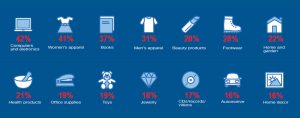Eletronic commerce and consumers
As e-commerce continues to rev up exponentially as a result of COVID-19, e-commerce has revved up exponentially with Canadians shopping online more than ever before. Retailers are doing what they can to keep up with this surge in online activity by finding unique and innovative ways to scale up their business and get products into the hands of customers. With online retail transactions on the rise, it’s critical for e-merchants to ensure that they have strong fraud prevention and detection practices in place to protect themselves and their customers.

Fraudulent online transactions are the dark side of e-commerce. The Internet is the “wild west” of fraud in a world that is becoming more secure at the offline payment level. It has become a point of easier access, without signatures, PIN numbers and chips.
When you are shopping online, Consumer Protection Ontario recommends you to follow same steps to minimize the potential risks: know who you’re dealing with—the website should provide basic information such as the business’ name, its address, phone number, email address, etc.; do not risk buying when the details are not clear; check the reputation of the business by reading reviews of their website and the item; remember to look at the full cost of the item, which includes all applicable taxes, shipping and handling charges, and duties; check that information on how to submit complaints is available on the website; print or save all agreements, receipts and related documentation in case your item is not delivered or if you need to return it; make sure that your credit card number and personal financial information are being sent over a secure and protected website and server. When shopping on an international website, you could also be exposed to risks, so before you buy make sure you know which currency the prices are displayed in and are aware of the exchange rate; the good(s) meets Canadian safety standards; you check international shipping costs for the transaction and for returns; the website has email or social media channels that offer customer service internationally and you check refund and exchange policies, and warranties that apply to customers internationally.
Canadians prefer Amazon to buy online
The e-commerce market, where consumers and businesses can buy and sell products and services exclusively through electronic channels, has been continuously developing in the past decade. Retail sales from worldwide electronic commerce are forecast to grow from 3.53 trillion U.S. dollars in 2019 to over 6.54 trillion in 2023. Thanks to its sizeable digital population, Canada has become a particularly profitable market in recent years. In late 2019, e-commerce retail trade sales amounted to almost 1.85 billion Canadian dollars, with approximately 28.1 million Canadians having made purchases online. Revenue generated within the retail e-commerce market is expected to surpass 33 billion U.S. dollars by 2024, up from 25.4 billion in 2019.

According Statistics Canada, in 2018, the top online stores in by e-commerce net sales were: Amazon; Costco; Walmart; Apple; The Bay; Best Buy; Home Depot; Wayfair and Gap Canada. In 2019, 25 million people in Canada bought goods and services online and in 2024 this number is expected to increase to 30.1 million people. A big number considering that in 2019 Canada had a population of 37.59 million. According to a March 2019 survey of adult Canadian internet users, it was found that 78 percent of respondents said they used a computer to make online purchases, compared to 25 percent of respondents who used a tablet for online shopping.
According Canada Post, in 2019, 80% of Canadians are hitting the buy button. While e-shoppers can be any age and live anywhere, certain demographics and lifestyles still show greater tendency toward this channel. The Canadian e-shopper in 2019 was mostly women (52%) and most of them lived in urban areas (45%). The annual average household income from a e-shopper in Canada last year was $92,656 and 38% of the couples who buy online don’t have children. Baby boomers, people between 53 and 72 years old are the ones who buy more online in the country (35%) and the second position goes to millenials, people with age between 18 and 37 years old (32%).
Canadians continue to buy from more categories. While computers and electronics, women’s apparel and books still dominate the top three, more segments are growing. Footwear, collectibles, both perishable and non-perishable groceries, automotive, pet supplies, even furniture are among the segments making traction online.
In Ontario when you make an online transaction, like a purchase from your favourite online business, you are entering into a type of consumer agreement known as an Internet agreement. If you are spending more than $50, the Consumer Protection Act has rules that apply. The business you are purchasing from must disclose certain information to you before you complete the transaction. This disclosure often comes in the form of a confirmation page that summarizes your purchase before you complete it. In this case, the confirmation page must include: the name of the business; the contact information; a fair and accurate description of the goods or services, including technical requirements; an itemized price list, including taxes and shipping charges; a description of each additional charge that applies or may apply, such as customs duties or brokerage fees, and the amount of the charge if the business can determine it; the total amount you must pay; the terms and methods of payment; the delivery address, date, cost and method; the rights, if any, that the business agrees you will have in addition to the rights under the Consumer Protection Act as well as the business’ obligations, if any, in addition to those under the Act, in relation to cancellations, returns, exchanges and refunds; if a trade-in arrangement is included, a description of the trade-in arrangement and the amount of the trade-in allowance; the currency that amounts are expressed in.
Shopify, a Canadian success story
There is a Canadian multinational company based in Ottawa that is writing a new page in the e-commerce book. Shopify offers to retailers the possibility to sell online and the help comes in different ways, such as payments, marketing, shipping and customer engagement. Shopify has more than 1,000,000 businesses using their platform in almost 175 countries, including Portugal. Right now, Shopify is the most valuable company in Canada, with a $163 billion market cap. That’s more than $30 billion more than the second most valuable company, the Royal Bank of Canada. If Shopify keeps up its recent gains for three more years, it will be a trillion-dollar company.

According to Canadian Centre for Cyber Security, there are a few steps that will protect you when you are shopping online: pay by credit card if you can, do not send cash; be on the lookout for prices that are too good to be true, they’re likely counterfeits; don’t use public Wi-Fi to shop online; read the privacy policy and find out how your information will be used; don’t respond to an email or pop-up message that asks for financial information, legitimate companies don’t ask for this information this way; read your credit card statements and check for unauthorized charges, make sure your firewall is “on” and don’t allow auto fill for your passwords or personal information, like your address, and never allow a site to store your credit card information. If for some reason you are the victim of a scam to mitigate the incident you should report to the Canadian Anti-Fraud Centre; contact your credit card company and reset your account credentials accordingly for related accounts, such as email or social media.
It is important to be aware of security and privacy issues associated with e-commerce. Some common security threats include fraudulent use of credit cards, computer viruses, spam (unsolicited e-mail messages) and theft of computers or information. Phishing is another type of security threat that involves an e-mail message that looks like it comes from an official source but links in the message go to a fake website where you may disclose personal information. Common threats to privacy include theft of personal information and inadequate protection of private information.
Joana Leal/MS








Redes Sociais - Comentários